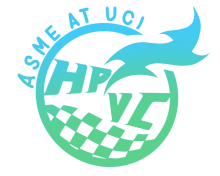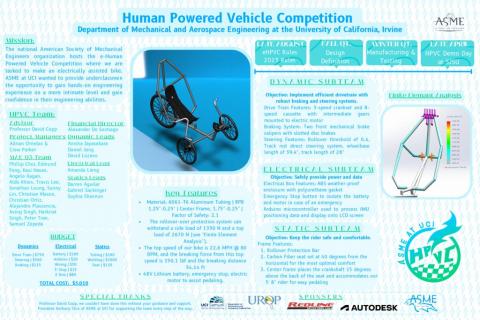Human Powered Vehicle Competition at UCI
Behind the Wheels
The American Society of Mechanical Engineers (ASME) hosts the e-Human Powered Vehicle Challenge (e-HPVC), a design competition that gives students the opportunity to apply their engineering knowledge through the design and fabrication of human powered vehicles.
While the term Human Powered Vehicle (HPV) refers to any means of transportation that is powered by human muscles, ASME is actually referring to a subclass of performance vehicles that include semi-recumbent bicycles or tricycles. These vehicles are designed to be fast, safe and ergonomic. They are equipped with performance drivetrains, aerodynamic fairings and rollover-protection systems to meet these certain attributes.
At the heart of this project is having a growth mindset. We want to build off of students' eagerness to learn and give students the space to learn, grow and practice. There are plenty of technical skills to grow in during this project like computer-aided design, finite element analysis, manufacturable drawings, electrical circuits and more. Through this project our hope is not solely that students become good engineers but become confident in their engineering skills.
Existing Solution
In 2016, a group of engineers named Aerovelo set the human-powered vehicle speed record. The group achieved a speed of 89.59 mph and required less than 198 watts of pedal power at 90 km/hr. To achieve this, Aerovelo uses recumbent bicycle configuration with a full composite frame. The drivetrain utilizes a front-wheel drive configuration with a large gearing ratio. The entire vehicle is surrounded by a missile-shaped fairing that greatly reduces the aerodynamic drag.
While the speed of the vehicle is outstanding, the design uses a large budget and is solely meant for achieving speed. Attributes such as comfort, handling, and all-terrain usage are not taken into consideration.
Endurance Race
Our team must design, fabricate, assemble and test a human-powered vehicle to compete in an endurance race. The endurance race is a 2.5 hour relay race with multiple laps around a closed course at least 1.5 km in length. The course is paved with patches of rough pavement. There will be turns in both directions as well as straight sections. There will be a maximum of 5% grade uphill and 7% downhill and no climb shall exceed a height of 30 m. At the start of the race, there will be a cargo that includes a grocery parcel that must be carried until the first grocery stop. Obstacles on the race include speed bumps as high as 5 cm, stop signs, hairpin turns of 180 degrees with a maximum radius of 8 m, slalom sections with series of tight turns, a section of rumble strip, and quick turns.
Safety Comes First
The design of the vehicle must also meet performance safety requirements detailed by the rules of the competition. The vehicle must demonstrate that it can come to a stop from a speed of 25 km/hr in a distance of 6 m. It must also have a turning radius of 8 m and demonstrate stability by moving for 30 m in a straight line at the speed of 5 to 8 km/hr. Each front wheel applied to the vehicle must contain its own brake.
The vehicle must use a rollover protection system that absorbs energy in a toppling accident. It must also prevent the body from contacting the ground as best as possible. A top load of 2670 N and a side load of 1330 N shall be applied without any indication of permanent deformation or fracture. There can be some elastic deformation, with a limit of 5.1 cm from the topload and 3.8 cm from the side load. Any permanent deformations must be attended to and fixed accordingly. The vehicle must avoid sharp edges and protrusions and all drivetrain components must contain guards.
E-powered Bike
The vehicle may utilize the use of one electrical motor. It must be rated for a maximum of 500 W. The vehicle is limited to one battery with a maximum capacity of 10 Ah. The voltage on board is limited to 48 V. All electrical equipment must be properly fused and the battery must be isolated from the driver using a rigid bulkhead. Lastly, the vehicle must have an emergency shutdown system that ejects that battery. Not only is the electric motor necessary for pedal assistance during the uphill portions of the competition, this provides the opportunity for students to work with green energy vehicles. The national ASME organization understands how green energy is the future and wanted this competition to reflect the work that students may get after graduation.
Sponsors
Henry Samueli School of Engineering at UC, Irvine
- David Copp | dcopp@uci.edu
American Society of Mechanical Engineers at UCI
- President (22-23), Anthony Chin | chinag@uci.edu
- Project Manager (22-23) Adrian Ornelas | afornela@uci.edu
- External Project Manager (23-24) Christian Mason | masonca@uci.edu
- Internal Director (23-24) Sophia Shannon | sgshanno@uci.edu


